Jordan Wright
February 2, 2015
Special to DC Metro Theater Arts
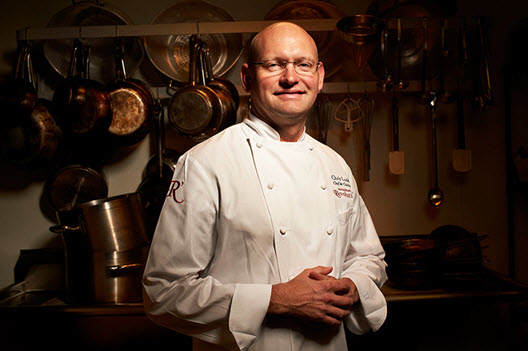 Chef Chris Lusk At forty-one, East Texas native and Johnson & Wales grad, Chris Lusk has seen the ins and outs of a few restaurant kitchens and learned a wide variety of international cuisines. After an externship in an Irish hotel he cooked Tex-Mex at Stephen Pyles’ Star Canyon in Dallas, Asian cuisine at an unnamed restaurant in Florida, and Italian at Otto Enoteca under Mario Batali. Later he worked with the iconic Brennan family’s Foodie’s Kitchen in Metairie and more recently at Commander’s Palace and Café Adelaide where he honed his Creole and Southern-style cooking. He is now Chef de Cuisine at Restaurant R’evolution in New Orleans.
At DC’s Acadiana in a room filled with shuckers, chefs, industry lobbyists and oyster lovers at the Gulf Oyster Industry Council’s Washington, DC event last month, I met Lusk over a platter of his incredible Crispy Oysters Rockefeller.
Jordan Wright – Can you describe the twist you put on the classic dish?
Chris Lusk – Traditionally it would be served on the half shell with a puree of purslane, chives, capers and other greens, then spiked with absinthe. Though it’s often spiked with Herbsaint, it really hadn’t been invented yet. So absinthe is used. Then it would be finished with breadcrumbs. My version has a crust made from dehydrated spinach, chives, green onions, breadcrumbs and Parmesan. Then it’s garnished with more Parmesan and a pesto made of green onions, chives and olive oil then spiked with absinthe. To prepare the oysters we drained the liquor off and marinated them the pesto then rolled in the breadcrumb mix. The crust really adheres to it. Then we flash fry them till oyster begins to plump and it’s still moist inside and crispy on the outside.
What we’re getting at this time of year is a smaller oyster. They go through phases during the year. I prefer to use a medium-sized oyster. At this time of year they are thriving in the cool water and they’re the perfect size and salinity.
You’ve been named one of Esquire magazine’s “Four Breakout Chefs to Watch”, cooked at the James Beard House and won the Louisiana Seafood Cookoff. What’s next?
I don’t know. I have a larger operation and bigger kitchen here with Restaurant R’evolution in New Orleans, and have a lot going on right now. They just opened their second restaurant, Seafood R’evolution outside of Jackson, MS in Ridgeland. It’s similar in concept but with more seafood.
Can you tell us about the dessert you prepared which prompted Esquire’s John Mariani’s to award you the “Best Dessert of 2011”?
It was a white chocolate biscuit pudding, a play on a dish my grandmother made when I was growing up. New Orleans is famous for bread pudding so my spin on it was what I was exposed to as a child where my grandmother used the leftover biscuits from breakfast. I took that inspiration and added white chocolate and a bit of Barq’s Root Beer Syrup on top, it’s an iconic soft drink that once was made here. Then I fried some pecans, which are from around here, as a garnish and I serve it with white chocolate ice cream.
I was very fortunate growing up to be exposed to farming. Growing up I spent summers with my grandparents who were farmers and I learned about canning and pickling using ingredients from the farm. My other grandparents were ranchers and raised cattle and hogs so we made sausage and used different cuts of meat. I’m thankful that I had the opportunity to learn about farming and ranching growing up.
I understand you are continuing your study of both Cajun and Creole cuisines. Can you talk about the differences between these two venerable cuisines?
Creole is more of the refined version of the French, Italian, German, and even African influences and Cajun reflects the more rustic, spicier and bolder flavors. Most Cajun is one-pot meals like jambalaya, gumbos, chicken fricasee and etoufées. What you see in New Orleans are the French dishes indicative of Creole. The use of Pernod, Herbsaint and absinthe lean more towards the Creole side. Although a lot of the lines have become blurred now – – and you can see the Creole and Cajun coming together.
Would you say you’re a fan of Paul Prudhomme, Emeril Lagasse or Justin Wilson?
That’s a hard question because I’m a fan of all of them for different reasons. Justin Wilson gave the first glimpse of what Cajun regional cuisine is. Prudhomme went to the next level with blackened fish, K-Paul’s and Commander’s Palace. He really put it out there on a larger scale. Then Emeril took it one step further. Those three guys have enabled me and my generation and the generation after mine to do what we do in New Orleans. Those guys are the ones that gave the younger chefs the opportunity to push the boundaries.
What are your favorite cookbooks?
I have Lafcadio Hearn and many others. My cookbook collection is all over the place – – Paul Prudhomme, Wilson’s books, Harold McGee and many others have influenced me in my style of cooking, including a lot of ethnic cookbooks that I use in different techniques of frying or pickling – like Japanese for instance. I learn from everyone including my dishwashers and sous chefs. You can never become too educated to learn from someone. Some of the most amazing meals I’ve ever had have been staff meals. The thing about New Orleans is everybody can cook here!
Opened in 1880 Commander’s Palace is one of the great American restaurants of all time. What did you learn while you were there?
That’s when I really started my education apart from culinary school. It really opened my eyes to Southern food. I learned a lot.
What signature dishes are you preparing at Restaurant R’evolution, the French Quarter spot where you are cooking now?
One of the dishes I recently put on was inspired by Vietnamese cuisine. It’s a Hoisin Glazed Grouper tied in with a blue crab pho broth and served with lightly pickled vegetables and rice noodles.
What new ingredients or techniques are on your radar these days?
I’m using lot of Asian ingredients like four different types of soy sauce such as Japanese and Filipino for curing eggs and making marinades, also different types of fish sauce and Indian spices. Sometimes just for myself I make sushi rice with marinated cobia and fresh wasabi. I’m inspired by the Vietnamese fishermen we have here.
Who was your first inspiration in the kitchen?
My grandparents were farmers and raised cattle and grandpa made sausage, things that are very popular now, so I was really fortunate as a child. I lived in a small city but spent summers with my grandparents who had a lot of land. We’d sit around and shuck corn, pick peas and can together. We do a lot of that at the restaurant pickles, jams etc. My grandpa used to clean out Coke bottles and make his own tomato juice and put the caps back on them. Man, that was the best tomato juice I’ve ever had!
What was the first dish you learned to cook and who did you serve it to?
I learned to make scrambled eggs as a child that I served to my mom and dad. I’m sure they were pretty rubbery and overcooked, but they were pretty nice about it.
What famous person would you like to prepare dinner for?
Thomas Keller.
Wow! No stress there.
Ha! No stress in that! I’m a big fan!
Jordan Wright
January 14, 2015
Special to DC Metro Theater Arts
 Chef Peter Chang One of the featured chefs for the Sips & Suppers dinners coming up next week is Peter Chang – an elusive chef known for ditching restaurant kitchens like a discardable cell phone. At last he has found in another accomplished chef, Gen Lee, the perfect partner to build an empire. The duo has already opened six successful restaurants around Virginia, with Arlington scheduled to open early February and another outpost in Rockville in March.
I’ve been a lucky duck to sample his cuisine twice in my life – once at a sumptuous banquet when he was the executive chef at DC’s Chinese Embassy in the 90’s, though I wasn’t aware he was the chef that oversaw the dozens of dishes offered at that lavish banquet. Years later on a hot tip I sought out his cooking at an obscure Chinese restaurant in a strip mall at the corner of Duke and Van Dorn in Alexandria.
Chang doesn’t dumb down his food for American palates. And it’s not for the faint of heart. As I recall the dish was the hottest, saltiest and most addictive chili pepper chicken I’d ever experienced. I have never forgotten it. By the time I planned on a return visit, he had scampered off for parts unknown leaving a trail of desperate fanatics in his wake.
Chang, who speaks no English, allows Gen Lee to act as his spokesperson. The two have cooked together for many years.
Whisk and Quill – Do you see everything in a yin/yang balance?
Gen Lee – Yes. It’s always going to be like that for us. In Sichuan Province it is very hot and wet and filled with trees. People who live there have to eat a lot of spicy food that’s why they use the Sichuan peppers.
Does Peter cook in one of the VA restaurants now?
Not on a daily basis. He cooks for parties and special events, but he also checks on every restaurant on a weekly basis. He’s very strict about that. I can’t tell you which restaurant he is cooking in at any given time, but he’s always cooking and he’s always training his cooks to get it right. We’re happy if its 90% right, because our recipes are very, very difficult. We don’t use sauce. For ten years when Peter and I worked as corporate chefs on a riverboat on the Yangtze River, we did the real, real Sichuan there.
How young was Peter when he first started cooking?
He was in high school. He always knew he wanted to cook and he went to cooking school at 18. He always watched his grandma cooking and helped her make lots of vegetarian dishes. You know, we don’t use much meat, but lots of vegetables mushrooms and such.
Does Peter listen to music when he’s cooking?
No, it’s very difficult. Everything is very quick. There are 20 different spices – different ones for different dishes – and it all happens fast.
What are some of the restaurants’ signature dishes?
The cumin lamb chops and bamboo fish, and everyone orders the dry-fried eggplant cut like steak fries.
Would you say your dishes are classic Sichuan?
Yes, it’s his specialty. But, for example, they don’t use lamb chops in China and the difference is the ingredients are better quality here.
Lately American chefs are using Asian ingredients in fusion cuisine and mixing things up. Where do you see this going?
A lot of chefs try it using French techniques. They are not using the real Chinese techniques and that worries me. These chefs are not Chinese. They are Hispanic or Korean. There are only a handful of real Chinese chefs here in America.
Chinese food has been losing favor to Thai and Korean in the past decade or so. Do you hope to bring back Chinese food to its earlier popularity?
Our dream is to bring back the real Chinese food, not just to make money. In a few years we know we can retire, but it’s not about that. Right now we have six restaurants. Already in our Richmond restaurant we are doing 500-600 a day. It’s like a war zone with like 100 people in line every day.
Will you be opening in the Northern Virginia area soon?
Yes, we will have two more restaurants – – one in Arlington and soon after in Rockville.
This interview was conducted, edited and condensed by Jordan Wright.
Dozens of prestigious local, national and world-renowned chefs will prepare the Sips & Suppers dinners on Sunday, January 25th. A separate evening of chef’s treats and cocktails takes place on Saturday, January 24th. Expect appearances by Joan Nathan, Jose Andres and Alice Waters. For further information and to purchase tickets to the fundraiser for Martha’s Table and DC Central Kitchen visit www.sips2015.eventbrite.com and www.suppers2015.eventbrite.com.
Jordan Wright
December 2, 2014
Special to DC Metro Theater Arts
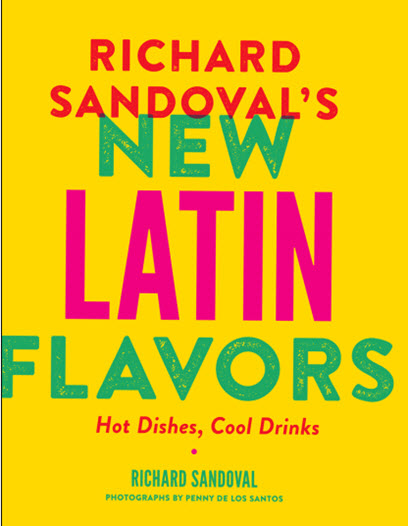
World-renowned chef and international restaurateur Richard Sandoval has penned his latest cookbook, New Latin Flavors – Hot Dishes, Cool Drinks (Stewart, Tabori & Chang) just in time to spice up the holiday season. Most of you will be familiar with his DC Latin/Asian fusion restaurants Zengo, Masa 14, El Centro D. F., but also Ambar with its flavor-forward Balkan dishes, La Sandia in Tyson’s Corner, or the chic, sleek Toro Toro, a churrascaria that opened downtown this April. With thirty-eight successful restaurants worldwide from Dubai to Paris and New York to Mexico, Sandoval’s empire is a testimonial to his delicious contemporary Latin cooking.
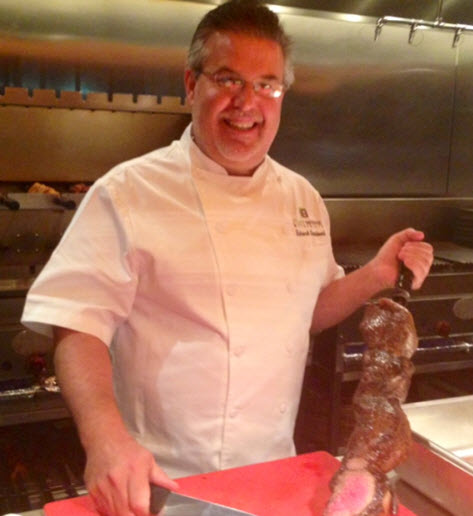 Richard Sandoval serving up churrasco at Toro Toro – Photo credit Jordan Wright In his fifth cookbook Sandoval has given us a collection of 125 inspired recipes that draw from the rich culinary traditions of Mexico, Peru, Venezuela and Argentina. Gorgeous photographs from Saveur photographer Penny De Los Santos grace the pages and highlight the mouth-watering recipes. For the first time Sandoval has tailored a cookbook expressly for the home cook spanning his repertoire of quesadillas, ceviches, arepas and enchiladas plus delicious Latin-inspired cocktails. Think tequila, mescal, cachaça, rum and pisco. Do you feel a party coming on?
Whisk and Quill caught up with Sandoval after he had dodged a blizzard in Denver to get to his DC book launch.
Whisk and Quill – What direction do you think food is going in today?
Sandoval – I think after the recession people’s ways of eating have changed dramatically. The last ten years it went very forward with all these molecular restaurants. I wanted to go retro. You know, back to our roots, back to comfort food and local ingredients, to make people feel comfortable again.
Would you agree that some of the best dishes from the past have been ruined by modernization? Although now I see more chefs returning to the classics but putting their own spin on it.
Absolutely! That’s always been my approach. A lot of my Latin cooking started with my grandmother in her kitchen. I would take dishes, like the mole, and interpret them in my way. I took the roots of these recipes and kept them the way they were meant to be.
What are your favorite ingredients?
I’ve always loved chiles and you’ll always see chiles in my cooking. But as far as cuisines, in the past three or four years I’ve been doing more Peruvian. I love it. And I love Thai food. I’ll be opening a restaurant in mid-January at the new City Center here in DC. It’s called Mango Tree. We brought a chef from Bangkok who worked at one of the other Mango Tree restaurants. I plan to take the roots of their cuisine, tweaking it a little bit as far as my flavor profile and presentation, but leaving the core as it is, maybe just changing the heat level and the balance. I’m incredibly excited. The restaurant already exists in London and Bangkok and Dubai. It’s classic Thai. I’ll just be readjusting it to what I do.
How do you begin to create a fusion dish? Do you start with a single ingredient or do you use your palate’s imagination?
I start with a single dish. The first fusion restaurant I did was Zengo, and Zengo means ‘give and take, back and forth’ in Japanese. It was two chefs, two cultures. First I would do a Latin dish. I hired an Asian chef to work with me and I would give it to him and he would ‘Asianize’ it. Then he would create an Asian dish and give it to me and I would ‘Latinize’ it. It’s two chefs collaborating. It wasn’t just me reinventing Asian, or what I thought it was. This way it made more sense to me.
Why is this book important to you?
When had my first Mexican restaurant twenty years ago, it was doing modern Mexican cuisine – – with more forward thinking. In this book I went retro with more traditional food and more comfort food. It’s very accessible to the home cook. It was very important to me to make sure that when people buy this book, they see it’s about having fun, that it’s not overly complicated where people would look at a recipe and say, ‘Ohmygod, I’ve got to go to Williams Sonoma to get the equipment and will I be able to find the ingredients?’ I wanted to be sure I made it very accessible and very fun.
Who would you most like to dine with living or dead?
I’ve always been very intrigued by Nelson Mandela. How someone can spend so much time in jail and then be able to come out and forgive. Most people would not be able to let go of what happened to them. He just kept moving on with his life and changed his country with his strong spirit and by sharing his ideas.
What if I asked you to name a woman?
Wow! I’ve always liked Shakira! She’s a beautiful woman and a great artist and I love her music.
Maybe she could sing to you.
I don’t think her husband would appreciate that!
We’re fantasizing here.
Okay, I could cook for her and she could sing to me.
Here are a few recipes to spice up any holiday party.
| PONCHE |
Striped Bass Tiradito |
Grilled Tostada with Beef Salpicón |
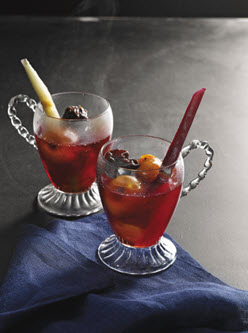 |
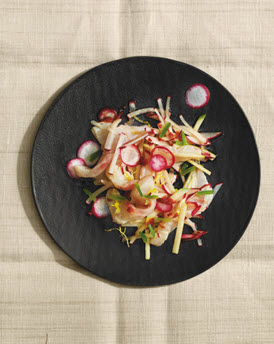 |
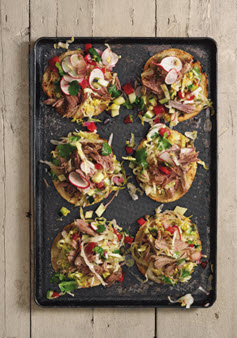 |
- 1/2 cup (2.0 g) dried hibiscus flowers
- (jamaica)
- One 3-inch (7.5-cm) cinnamon stick
- 1 cup (200 g) sugar
- 1/2 cup (130 g) tamarind pulp, broken
- into pieces (see Notes)
- Two 4-inch (10-cm) pieces fresh or
- frozen sugarcane, peeled and cut into
- 12 sticks (see Notes; optional)
- 24 fresh or drained bottled tejocotes
- (see Notes)
- 2 ripe guavas, cut into 12 wedges
- (see Notes)
- One 375-ml bottle (1. cups) 100%
- agave tequila, brandy, or light rum
- 1/4 cup (60 ml) orange-flavored liqueur,
- such as Grand Marnier
- 12 pitted dried plums
The Mexican warm fruit punch of the holiday season, ponche is sometimes nothing more than spiced syrup with booze. My family recipe is better, and infused with the tropical flavors of hibiscus and tamarind.
Serves 10 to 12
[1] Bring 2. quarts (2.5 L) water to a boil in a large nonreactive saucepan over high heat. Remove it from the heat and add the hibiscus flowers and cinnamon stick. Let them stand for 5 minutes. Add the sugar and tamarind and bring them to a simmer over high heat. Reduce the heat to medium-low and simmer, stirring often to break up the tamarind, for 5 minutes. Strain the liquid into a large heatproof bowl, pressing hard on the solids; discard the solids.
[2] Return the liquid to the pot. Add the sugarcane, if using, and bring the liquid to a boil over high heat, stirring to dissolve the sugar. Reduce the heat to medium and cook the liquid at a brisk simmer for 5 minutes. Strain it again to remove any tamarind debris.
[3] Return the tea to the pot and add the tejocotes and guavas. Simmer until the guavas are tender, about 5 minutes. Stir in the tequila and liqueur and simmer just until the mixture is hot. Remove it from the heat, add the plums, and let them stand for 5 minutes. (Do not add them earlier or they will get too soft.)
[4] To serve, return the pot to very low heat to keep the ponche warm. Ladle the ponche into mugs, adding the fruits to each serving. Serve it hot. Notes You can substitute 1⁄3 cup (75 ml) tamarind concentrate for the tamarind pulp. If neither is available, use . cup (120 ml) fresh lemon juice. Fresh or frozen sugarcane is available at Latin groceries and large supermarkets, and is often sold peeled. If the thick skin needs to be removed, use a large knife to chop the cane into manageable 4-inch (10-cm) lengths. Stand the pieces on end to cut away the peel. Cut the sugarcane lengthwise into thick sticks. Tejocote is a small round stone fruit (that is, with a large seed in the center). It is sold fresh at Mexican groceries around Christmas time, and in jars year-round.Kumquats or crabapples are good substitutes because they are similar in size to tejocotes. You may want to alert your guests that the tejocote seeds can be spit out. Pineapple guava, about the size of a large lime, is the most widely available variety around Christmastime. If it is not available, substitute about one-quarter of a pineapple, peeled, cored, and cut into bite-size pieces. Goya, the leading Latin food product manufacturer, sells a nonalcoholic ponche in a jar with enough tejocotes, sugarcane sticks, and guavas for this recipe. Drain and discard the liquid—you really just want the fruit. Leave the tejocotes intact, but cut the sticks and guavas as needed to yield twelve pieces of each. |
with Ponzu, App le & Radish Tiradito de lubina rayada con salsa ponzu, manzana y rábano
- 1/2 Granny Smith apple, peeled
- 2 large radishes, trimmed
- 14 ounces (400 g) skinless striped
- bass, cut on a diagonal into .-inch
- (6-mm) slices
- 1Ž2 cup (120 ml) Ponzu, homemade
- (page 48) or store-bought, chilled
- Finely grated zest of 1 large lemon
- Sriracha, for serving
Tiradito is the South American version of ceviche, and it often has Asian influences, such as the ponzu in this recipe. It is one of the lightest (and quickest) first courses you’ll ever make, yet at the same time, it is one of the most flavorful. There are many good brands for sale, but it is also easy to make your own (page 48), and it is worth the minimal effort for this recipe, where it plays such a big role.
Serves 4
[1] Just before serving, use a V-slicer or mandoline to cut the apple and radishes into julienne. (You can also use a chef’s knife.) Combine them in a small bowl.
[2] For each serving, fan the bass on a chilled
serving plate with a rim. Spoon 2 tablespoons of the ponzu around, but not on, the bass.Top each with one-quarter of the apple mixture and the grated lemon zest. Serve immediately, with the Sriracha on the side. |
tostada con salpicón de res
For the Salpicón Dressing:
- 1/4 cup (60 ml) distilled white vinegar
- 3 tablespoons fresh lime juice
- 3 tablespoons minced red onion
- 2 teaspoons dried Mexican oregano,
- crumbled
- 1 teaspoon kosher salt
- 1/2 teaspoon freshly ground black
- pepper
- 3/4 cup (180 ml) olive oil
- For the Grilled Tortillas:
- 6 corn tortillas
- Canola oil, for brushing
- For the Salpicón:
- 1/2 head iceberg lettuce, cored and
- shredded
- 1/2 seedless (English) cucumber,
- cut into 1/2-inch (12-mm) dice
- 2 plum tomatoes, seeded and cut into
- 1/2-inch (12-mm) dice
- 4 radishes, cut into 1Ž4-inch
- (6-mm) dice
- 1/2 cup (90 g) drained nonpareil capers
- 1/4 cup (5 g) coarsely chopped fresh
- cilantro
- 3 cups (645 g) Shredded Beef Filling
- with Tomatoes and Chilies (page 175),
- at room temperature
- 2 ripe Hass avocados, thinly sliced
There are many different versions of salpicón, the hearty salad that is a specialty of both Mexican and Colombian cooks. The constants are shredded meat (or poultry or chopped seafood) and a sharp dressing. I like to serve it on grilled tortillas for a smoky crunch that everyone loves. (The tortillas can also be fried in oil, if you wish.)
Serves 6
[1] Make the dressing: Whisk the vinegar, lime juice, onion, oregano, salt, and pepper together in a medium bowl. Gradually whisk in the oil.
[2] Grill the tortillas: Prepare an outdoor grill for direct cooking over medium-high heat. For a charcoal grill, let the coals burn until they are covered with white ash and you can hold your hand about 1 inch (2.5 cm) above the cooking grate for about 3 seconds. For a gas grill, preheat it on high, then adjust the heat to 450oF (230oC). Or preheat a stovetop grill pan over medium-high heat.
[3] Lightly brush the tortillas on both sides with oil. Place them on the grill and cook, with the lid closed as much as possible, turning them occasionally, until they are crisp and lightly charred, about 2 minutes. Remove them from the grill.
[4] Make the salpicón:
Toss the lettuce, cucumber, tomatoes, radishes, capers, and cilantro with the dressing in a large bowl.
[5] Place a tortilla on each of six dinner plates. Divide the lettuce mixture among them, topped by the beef. Top them with the sliced avocado and serve immediately.
Shredded Beef Filling with Tomatoes & Chilies Ropa vieja con tomates y chiles
- 2 tablespoons canola oil, plus more
- as needed
- One 2.-pound (1.2-kg) beef brisket,
- fat trimmed to 1⁄8 inch (3 mm)
- Kosher salt and freshly ground black
- pepper
- 1 medium yellow onion, chopped
- 4 jalapenos, seeded and coarsely
- chopped
- 4 garlic cloves, minced
- One 28-ounce (785-g) can fire-roasted
- tomatoes
- 2 teaspoons dried Mexican oregano
- . cup (5 g) finely chopped fresh
- cilantro
- 2 tablespoons fresh lime juice
- 1 teaspoon mesquite-flavored liquid
- smoke (optional)
Slowly simmered with tomatoes and jalapenos, this braised brisket is called ropa vieja (“old clothes”) because the shredded meat looks like raggedy clothes. There will be about a cup or so of the cooking liquid left over—be sure to save it as a sauce for pasta or polenta. You may even want to serve this as a main course with Mashed Potatoes with Oaxaca Cheese (page 145).
Makes about 4 cups (910 g)
[1] Position a rack in the bottom third of the oven and preheat it to 350oF (175oC).
[2] Heat the oil in a Dutch oven over medium-high heat. Season the brisket all over with 1 teaspoon salt and . teaspoon pepper. Place it in the Dutch oven, fat-side down, and cook it, turning after 5 minutes, until it is nicely browned, 10 to 12 minutes. Transfer the brisket to a plate.
[3] If needed, add another 1 tablespoon oil to the Dutch oven. Add the onion, jalapenos, and garlic and reduce the heat to medium. Cook, stirring them occasionally, until the onion is softened, about 3 minutes. Stir in the tomatoes and their juices with the oregano and bring them to a boil. Return the brisket to the Dutch oven and add enough hot water to come about three-quarters up the side of the meat. Bring it to a boil over high heat.
[4] Cover the Dutch oven and transfer it to the oven. Bake until the brisket is fork-tender, about 2. hours. Transfer the brisket to a carving board, tent it with aluminum foil, and let it stand for 10 minutes. Set the cooking liquid aside.
[5] Using a sharp knife and your fingers, shred the brisket with the grain. Roughly cut the shredded beef across the grain into bite-size pieces. Transfer it to a bowl. Skim off the fat on the surface of the cooking liquid. Stir in about one-third of the cooking liquid to lightly moisten the shredded beef. Add the cilantro, lime juice, and liquid smoke, if using, and mix it again. Season the beef to taste with salt and pepper. (The beef can be cooled, covered, and refrigerated for up to 2 days or frozen for up to 2 months. Reheat it before using.) |
Jordan Wright
November 30, 2014
Special to DC Metro Theater Arts
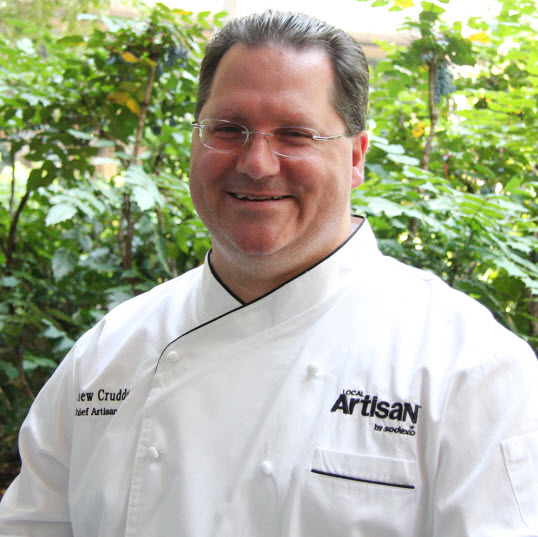 Matthew Crudder – Executive Chef at National Geographics Presiding over National Geographic’s Washington, DC kitchens for over two years, Executive Chef Matthew Crudder draws on his considerable experience. A graduate of the New England Culinary Institute, the 45-year old chef hails from Ann Arbor Michigan, where he briefly attended the University of Michigan before finding his passion for cooking. His resume reads like a primer for aspiring chefs – – The Four Seasons in Las Vegas and Chicago, the Ritz-Carlton in Philadelphia, the Fairmont in Washington, DC and Sodexo clients, AOL, Gannett, USA Today and Fannie Mae. “NatGeo”, as it is fondly called, is currently served by Sodexo who launched their “Local Artisan” program at NatGeo’s headquarters. Crudder had taken a lead role in sustainability throughout his time at Sodexo and eagerly took the lead in this innovative program described as “a locally-sourced sustainable process highlighted by a chef-driven approach to natural cooking”.
On December 4th the Society will host a local, sustainable farm-to-table dinner in its historic Hubbard Hall, the first headquarters of the National Geographic Society, located at 1145 17th St., NW Washington, DC in DC’s Golden Triangle District.
Inspired by the exhibition “FOOD: Our Global Kitchen”, the evening will feature a guided five-course meal with local wine, beer and cider parings. During dinner Archivist Renee Braden will share the history of National Geographic and discuss its rich relationship with food. To purchase tickets go to http://events.nationalgeographic.com/special-events/2014/12/04/farm-table-hubbard-hall/
Earlier this week Whisk and Quill took the opportunity to speak with Crudder in advance of NatGeo’s exciting event.
What are your earliest food memories?
Growing up my family kept gardens and I started my involvement at home when I’d hear, “The water is about to boil go and get the corn or go pick the string beans.” Or “If you’d like jam on your toast tomorrow, here’s a bucket. Go collect the blackberries on down by the road.” So my grandmother and mother were big influences in terms of really fresh all-American cooking. I mean in the more traditional sense as opposed to the concession stand or freezer aisle.
What was your first professional experience?
I started off in an Italian kitchen and fried zucchini was my specialty for the first two days of my training. But the first real dish I learned to prepare from start to finish was osso buco. And it’s still a dish that I love to prepare.
I like Marcella Hazan’s recipe for osso buco.
Well, actually on many occasions when people say they want to learn to cook, the first thing I do is hand them Marcella Hazan’s Essentials of Classic Italian Cooking!
Before I’d even been to cooking school I remember making the first couple of recipes from her book, which gave just four ingredients – – although the results were so much more than that.
Her description of the techniques is what makes her recipes so exceptional. It really helps you to understand how the process should be looking and smelling so you know what you’re supposed to be doing. And then there’s that sense of risk that comes with doing the braise! You put it in the oven and you can’t do any more. You just have to wait.
What style of cooking is your favorite?
I really like what we’re doing now with the “Local Artisan” – – the farm-to-table style program that allows simple cooking techniques and the product itself to showcase the quality of the food. A bit of salt and pepper, olive oil and lemon juice with a properly sautéed or roasted item is maybe all you need – – not hiding things under heavy sauces and sugars and things like that. The food is just so honest and recognizable the flavors really shine through. And it’s healthier too – – if you’re careful with the oil!
We did a small test for the dinner we’ll be doing next Thursday and we’ve been passing it around the kitchen today to let everybody sample it. It’s just unadorned goat’s milk ricotta. There are only four ingredients to making it. But before we drizzled it with olive oil or added salt and pepper, the response we got, that it was so fresh and creamy and wonderful, was so rewarding.
Can you describe the types of events typical to NatGeo that you create dinners for?
The part of what I love about working for National Geographic is that whatever they’re involved in we’re going to be doing themes based on their event schedules. Everyday I practice and focus on our cuisine using natural products and techniques and then I get to use these adventures on our special events.
We’ve done a man-on-Mars themed dinner and a Spinosaurus themed dinner as well as different cultural menus. For South America we focused on the Amazon and Peru for the “Peruvian Gold” exhibit. There are a lot of opportunities to be creative. I do research to learn about cuisines I might not know about. For example, for a group from Durban, South Africa, I got to dig around on the Internet and source some products to make it as authentic as possible, and our guests really got into the spirit of it.
Can you tell me a bit about the plans for the upcoming dinner on December 4th?
The house made goat’s milk ricotta I mentioned will be paired with roasted and pickled beets. Some of the other elements I want to hold in surprise. In terms of the event it will be a farm-to-table event. But here we are in the beginning of December in the Mid-Atlantic and many things are not growing at this time of year. When we found out about the event we made up some tomato jam at the height of the season for heirloom tomatoes.
I’m not going to serve a local hothouse tomato that doesn’t taste like anything just because it’s local. And I’m not going to say we can’t have tomatoes because they’re not growing in the field near here now. That wouldn’t be what was done in a more traditional setting either. Back then you would have to take the bounty and preserve it in as many ways as you could. So we have a number of items sprinkled around the menu that are taken from this summer’s bounty which we have prepared and preserved – – whether it was by drying or canning or freezing or pickling – – to hold on to the peak of freshness.
We’ll be featuring key ingredients in every dish that have been locally sourced. We have a direct relationship with farmer/owner Greg Keckler of Orchard County Produce in Gardeners, PA who comes here nine months out of the year on Tuesdays. He supplies subscriptions for a CSA we have in the building and holds a farmers market in our courtyard. His quinces, apples, root vegetables, Swiss chard and kale will be incorporated into the menu.
Will there be other local providers involved in the dinner?
I work very closely with my meat and fish providers to select products that will be readily available locally. The beef we’ll use is Certified Angus Beef but it’s differentiated from other Certified Angus Beef by the fact that the product comes from a “single stream” from a particular small group of farms in Pennsylvania, so the animals are born and raised there. The people that raise the animals also grow the feed for the animals and they’re processed and shipped locally. That’s different from the standard way most Angus cattle are raised. Their entire life span, as well as what they’ve been fed, is all along the line of sight of the ranchers that handle them. So that’s very exciting.
We also will feature some wonderful seafood from the Chesapeake region. And we are working with J. Q. Dickinson Salt-Works from the Kanawha Valley in West Virginia using their wonderful salt. The fact that something so basic can be a hand made product, I think is really special.
We’re not going to say, oh, that product is one county away, so we can’t use it. What we try to share with our guests is the evolution and story of how the food supply evolves and ebbs and flows through the course of the year.
One of the things that we’ve done here is to compare food miles, something I’ve shared on National Geographic Live. We don’t really track it, but we did compare how many miles food travels – – showing how near or far products have to travel when they are purchased from standard sources. So if you are basing it on the availability of food, the radical difference in terms of the miles traveled by the food is a factor of, not tens, but hundreds of miles and we’re very aware of that.
Jordan Wright
July 12, 2014
Photo credit Jordan Wright
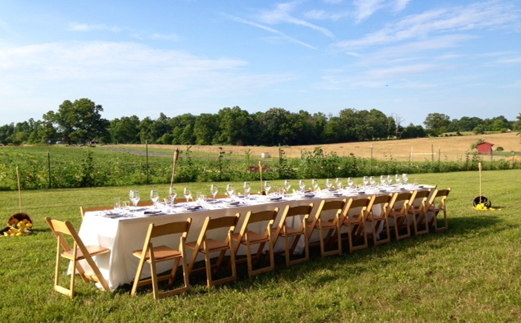 At East Lynn Farm in Round Hill The minute you turn onto Snickersville Turnpike from the John Mosby Highway, the stress of the city begins to fall away like husk off corn. It’s the route I chose to drive to East Lynn Farm in Round Hill, Virginia for a field to plate dinner. In my book driving through a green leafy tunnel, pierced through by the afternoon sun’s golden rays, is a far better introduction to the charms of the countryside than the countless traffic lights, strip malls and gas stations along Route 7. But curving around country lanes and gazing out onto wide swaths of open farmland, allows the spirit to ease mindfully into a more peaceful dimension.
As I pulled into the driveway I noticed a few other guests had already arrived. One of the chefs greeted me from the front porch and steered me to a path behind the historic farmhouse where a long linen-covered table beckoned beneath tall pines. Edging the perimeter of the bucolic scene, farm baskets overflowed with yellow squash. And torches, raised up on bamboo poles, ringed the newly mown grass. On the patio guests introduced themselves and sipped wine in the softening light. Very quickly a shared sense of adventure and camaraderie took hold of the strangers.
Before dinner service farm owner Georgia Ravitz led the twenty or so of us on a brief tour. Surrounded by hayfields dotted with weathered red barns, we strolled down the neat rows of the four-acre vegetable and flower gardens, stopping along the way to nibble on vining peas and spearmint while imagining them in our supper-to-be. On the north end of the gardens pasture-raised chickens foraged on ground insects and a small pond edged in willows afforded ducks and frogs a calm respite from the day’s heat.
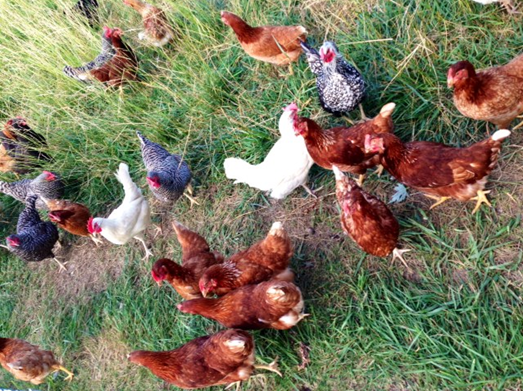 Thank you, chicks Inside the farmhouse’s state-of-the-art kitchen, three passionate chefs and their capable crew were abuzz with activity. Terence Tomlin, Mackenzie Kitburi and Kiril Stavrev had set the stage for their six-course dinner and all hands were on deck.
Kitburi and Tomlin had met at Range, Bryan Voltaggio’s American Modern restaurant in Friendship Heights. Coincidentally they had started their jobs there on the same day and, as Kitburi describes their friendship, “It took Terry awhile to warm up to me, but we’ve been clicking ever since.” Eventually Kitburi told his new friend about an idea he’d been hatching. He wanted to start a company that would stage elegant pop-up dinners in supper clubs and existing restaurants. “I told him about my plans and my vision and he got on board right away,” Kitburi explained. Stavrev, who brought along Marriott and Ritz-Carlton experience, came into the brotherly mix soon after. “He’s a great cook who complements us. We’re definitely on the same wave-length,” Kitburi says.
The company they formed, Capital Taste, is not a caterer per se. As Kitburi sees it, “My vision is to switch up the dining experience with unique menus and themes. I prefer a tasting style menu so people can experience a number of different tastes during one sitting. We want people to come to us for the food. We don’t plan to bring food to people.”
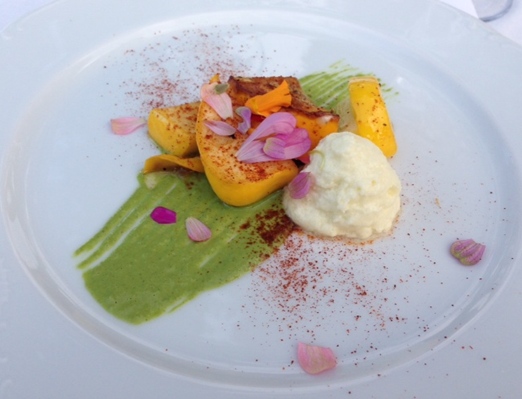 Summer Squash Mousse This evening’s pop-up was the young chefs’ first in a summer series of five farm dinners and it began with a beautiful amuse bouche of watermelon, fennel and mint, followed by zucchini mousse with herbs, and then, a sheer tomato consommé expressed by the fruit and liquid from heirloom tomatoes and crowned by a single squash blossom.
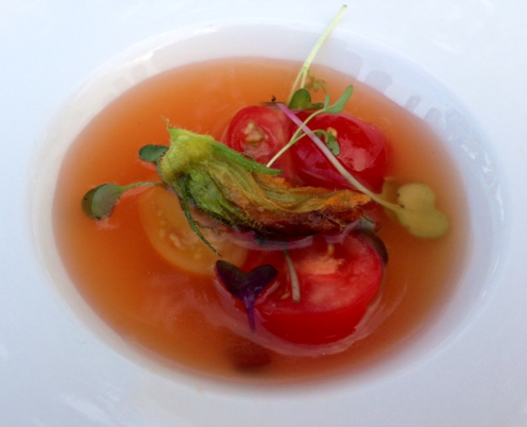 Tomato Consommé with Squash Blossom Potato rösti topped with a sunny hen egg (Thank you, little chicks!), became a foil for truffle hollandaise. And after segueing the wine pairings from whites to reds, a duo of rack of lamb and lamb sausage with chimichurri and eggplant purée was introduced.
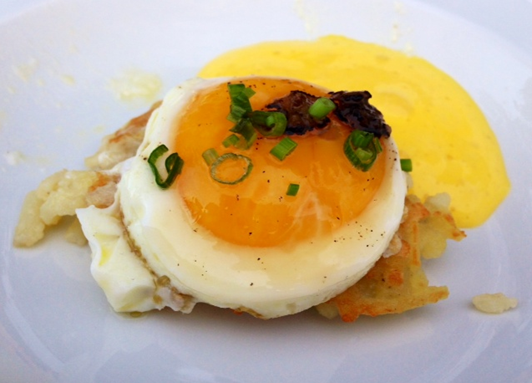 Sunny Hen Egg on Potato Rosti with Truffle Hollandaise As the light grew dim, candles and torches provided the table’s sole source of illumination, and our fourth course arrived. Slices of the farm’s Angus strip loin steak got the benefit of charred baby Japanese eggplant plus two sauces – a delicate soubise hinting of onions and a glistening summer truffle sauce.
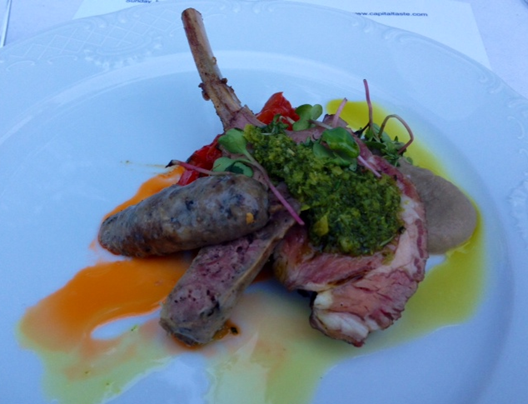 Lamb Rack and Lamb Sausage The lively conversation and breathless compliments paused only when someone remarked on the moon. A zillion stars sparkled in the Western sky as fireflies performed their staccato dance across the darkened horizon, and the final dish was presented. On a magical night where every course had delivered the promise of pasture and garden, the chefs had given the final nod to the harvest with Tomlin’s specialty, vegetable ice cream – one of red beet, the other using white asparagus. Impossible concepts that proved transcendent before melting into a lasting memory.
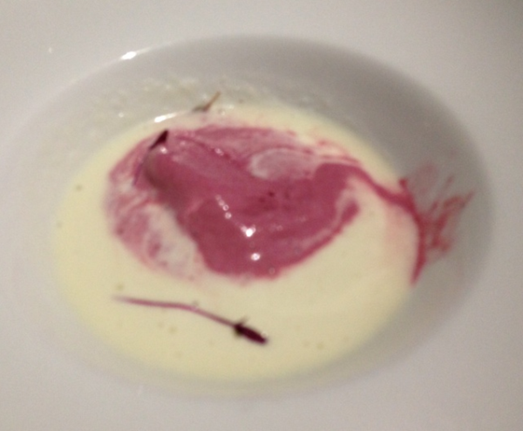 Duo of Red Beet and White Asparagus Ice Creams To dine in such a way is a wonderment. To partake of nature’s bounty expressed in sublime artistry, is truly divine.
The next dinner at East Lynn Farm will be on Sunday evening, July 20th. To book your reservations go to [email protected]. To learn more about the Inn at East Lynn or the farm’s CSA program go to www.EastLynnFarm.com.
Jordan Wright
June 4, 2014
all photo credit to Jordan Wright
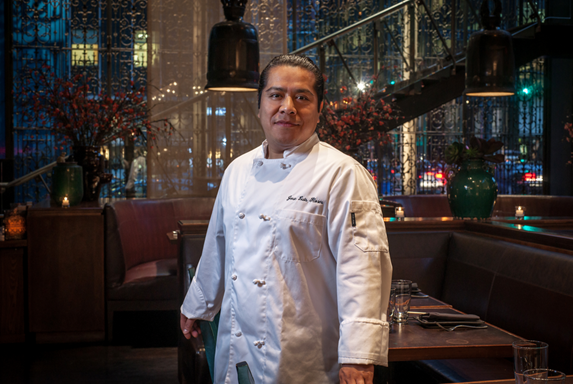 Pastry Chef Joseluis Flores You may have noted that I only occasionally report on desserts. Often they can be so cloyingly sweet, targeted to a juvenile palate, or just something to bump up the check total. And unless there is a designated Pastry Chef on board, I find that this is too often the case.
Joseluis Flores, Richard Sandoval’s Pastry Chef and Executive Chef for Kitchen Operations, does not fit into any of the aforementioned categories. He is an astounding and accomplished chef who has been recognized by Star Chefs as a “Rising Star”. As Pastry Chef for Toro Toro he has created two desserts that I would get on a red-eye for. Thankfully I do not have to. His “Cortadito Bar” and the dreamy “Deconstructed Key Lime Pie” are on the I Street restaurant’s printed menu. Recently I spoke with Flores about his work and inspirations.
Whisk & Quill – What was your first dessert or memory of something sweet?
Joseluis Flores – I’d say the orange pound cake my grandma made. As the only boy in the family I learned from her. As kids we’d all gather around and she taught us how.
W&Q – What was the first desert you made?
JF– The orange pound cake certainly, and a chocolate pound cake too. We usually ate these cakes once a month on a Sunday and not necessarily for a special occasion.
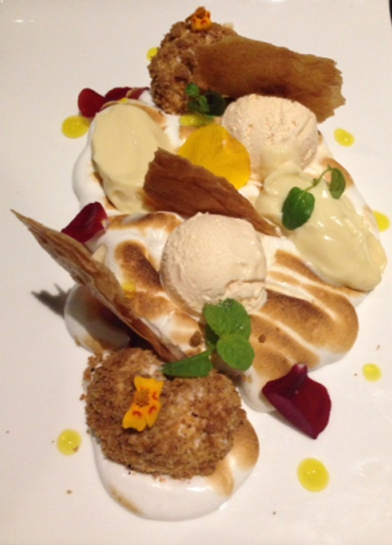 Deconstructed Key Lime Pie W&Q – Can you talk about how you came up with the Deconstructed Key Lime pie? I loved it. It is beautiful and unpretentious as well as delicious. Something you want to dig in to, not stand back from.
JF– Italian meringue a rich key lime custard and garnished with complementary flavors without missing the essence of the idea. I think people overthink desserts. They try to put too much stuff in it. Sometimes the simplest thing is the most challenging.
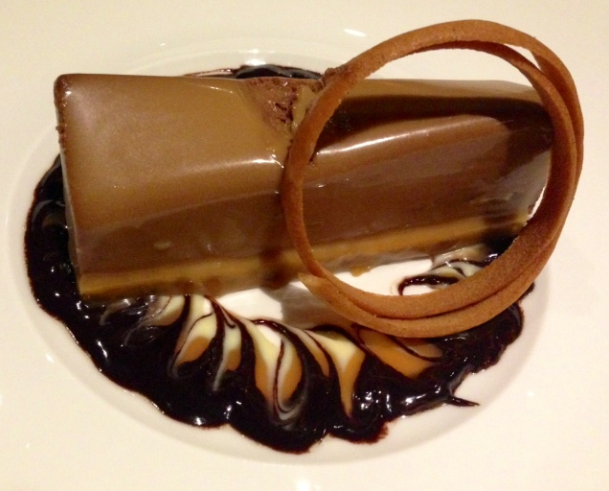 Cortadita Bar – another of Joseluis Flores’ divine desserts W&Q – What about your lavish Cordadita Bar?
JF – It’s a takeoff on the Cuban coffee that’s an espresso with a dash of milk.
W&Q – What kind of chocolate do you prefer?
JF – I use many different kinds, but for that dessert I use Valrhona 64% chocolate. It’s a combination of white and dark chocolate and a lot of coffee and milk in the mousse. The base is a smooth and silky almond and hazelnut cake, a typical French genoise.
W&Q – Who are your greatest professional influences?
JF – I’d have to say Jacques Torres and Francois Payard, and from elBulli, Ferran Adria, and his brother, Albert Adria, whom I met once at a Star Chef event in New York.
W&Q – What is your favorite dessert?
JF – I like everything chocolate! I like a simple chocolate mousse with raspberries. For myself, believe it or not, I like hot apple pie with chocolate ice cream on top. Sometimes I make apple empanadas in the restaurant using pie dough and eat it with cinnamon and vanilla-flavored chocolate ice cream that I make with Abuelita using some smoked ancho chiles.
W&Q – What types of sugar do you use?
JF – I use granulated white sugar and a lot of brown sugar too, both dark and light, for cookie dough. I use agave for marinating fruits and make a flan with piloncillo. Also I like agave syrup with spices for making my churros. Occasionally I use sugar from beets or dates.
W&Q – What do you think is the next trend in desserts?
JF – Wow! That’s difficult to say. But I think a lot of the pastry chefs are going back to the basics, not so much molecular gastronomy. Everything has its time. A lot of the chefs give us the trend of the food. But some of the desserts have become very expensive to create and not everybody can afford that. A lot of restaurants are using more basic ingredients. So many restaurants try to overdo, and just don’t decorate the plates right. Not everyone can play with the more molecular techniques.
I make one dessert that is served only in Miami and New York. It is a Mexican cream cheese mousse with a cream cheese crust and cookie crumbs and French preserves with strawberries and raspberries. We use the same ingredients to decorate the plate. I try not to go beyond or crazy. You can just take one ingredient and transform it with out losing its integrity.
W&Q – How do you get all your ideas?
JF – The company we have now with Richard [Sandoval], affords me a lot of opportunities to be creative. It also lets me explore flavors and ingredients from around the world to create new Latin and Asian flavors. With so many combinations at hand, I can always create something new.
W&Q – Can you describe the differences in Latin-inspired desserts?
JF – People often ask me, “What’s a Latin dessert, a Peruvian dessert, a Mexican dessert?” If you look back in history there was no sugar in America. It was honey and vanilla. We didn’t have these things until the mix of cultures. For example in Argentina alfajores is a cookie made of corn starch and sugar that they are very proud of. Those desserts came from the Old World, places like Arabia and Dubai – – and the kind of sugars they use. We have to mix the Latin flavors somehow – – otherwise we end up with nothing.
For example some fruits came from America. Pineapple, that’s now used all over the world, was once for the very rich. All these flavors like guava and mamey, they came from Latin America and were brought to Europe.
When I was writing my first book [Dulce: Desserts in the Latin-American Tradition 2010] I did a lot of research about baking ingredients. For example the vanilla bean was brought from Mexico to Spain and then spread around the world. Then, look at who are the masters of chocolate – – Switzerland and France. Chocolate was brought to Europe from the Americas.
W&Q – What’s next for you?
JF – This September I will be at a Star Chefs competition in New York City. There are usually 20 different pastry chefs from around the country. I really like to do this because a lot of the money goes to the students. Plus it keeps me in shape. The last time I went I had to train for two weeks! I like to see people from the industry and all the latest technology so I can have a knowledge of what’s in the marketplace. Like a lot of other pastry chefs, I like the PacoJet [ice cream machine] a lot and also all the different Silpat pans and molds that allow me to create different shapes.
W&Q – Is there another book we can look forward to?
JF – Actually, I am working on another book. The last one took me a couple of years to develop, compile and test the recipes, so I imagine this one will too. I like to put all my memories in it.
This interview was conducted, condensed and edited by Jordan Wright.
|

















